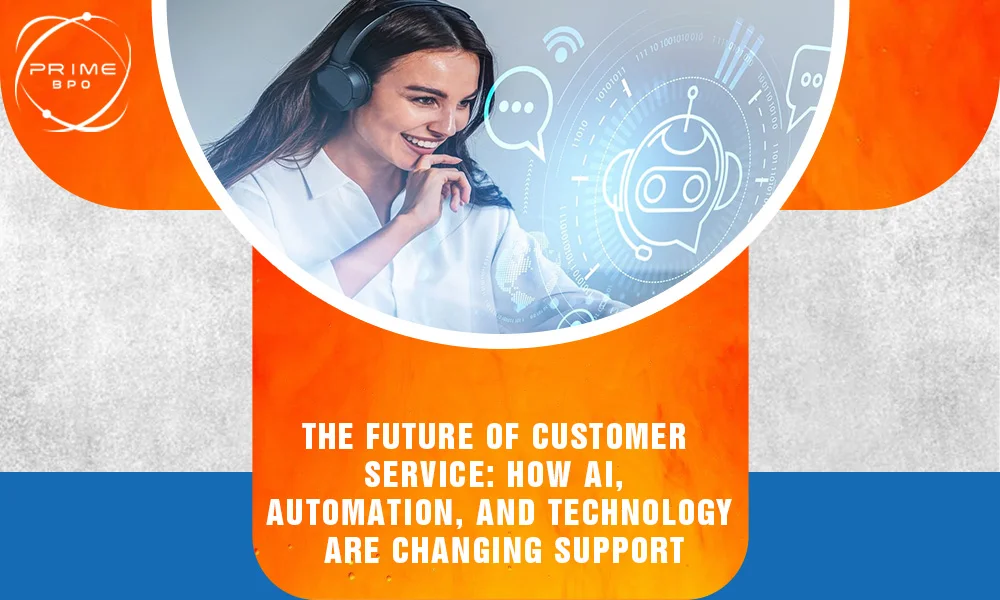Introduction
Customer service has always been a deciding factor in business growth. While product quality and pricing are important, customer service is what creates trust and long-term relationships. In the past, support was limited to phone calls and emails. Today, we have live chats, AI chatbots, and social media support—all working together to deliver faster, smarter, and more personalized service.
But this is just the beginning. The future of customer service is evolving at a rapid pace, influenced by artificial intelligence (AI), automation, and other emerging technologies. At the same time, customer expectations are increasing—people no longer just want answers; they want businesses to anticipate their needs and solve problems before they even occur. This new era of customer service demands innovation, empathy, and adaptability.
The Changing Landscape of Customer Service
Why Customer Expectations Are Higher Than Ever
Today’s customers are more demanding than ever before. With companies like Amazon and Apple setting the gold standard, people now expect instant responses, personalized interactions, and seamless experiences across every platform. The modern customer is digitally savvy and knows there are multiple options available, so if one company fails to meet their expectations, they can quickly move to a competitor.
This growing demand is why businesses are under pressure to provide faster, more reliable, and proactive service. Customers want businesses to know their preferences, remember past interactions, and provide solutions quickly. In short, the customer is no longer willing to wait, and companies must adapt.
The Automation Trend in Customer Service
Automation is no longer just a trend—it is becoming the foundation of modern customer service. Businesses are increasingly turning to automation to reduce response times, manage high volumes of inquiries, and improve efficiency.
For instance, automated chatbots can answer frequently asked questions in seconds, while interactive voice response (IVR) systems guide callers to the right department without wasting time. Similarly, self-service portals empower customers to resolve issues on their own, reducing the workload on customer service teams.
This shift towards automation does not mean removing humans from the process. Instead, it helps companies balance efficiency with quality. Routine tasks can be automated, while human agents focus on solving complex or sensitive issues that require empathy and understanding.
The Role of AI in Customer Service
How Does AI Improve Customer Service Efficiency?
Artificial intelligence is taking automation a step further by not just answering questions but also learning and adapting over time. AI-powered systems can analyze customer behavior, predict needs, and deliver highly personalized responses. For example, when a customer contacts a bank, AI can instantly pull their account history and provide relevant solutions without delay.
This ability to provide faster, smarter, and more personalized service makes AI a game-changer. Businesses are using AI to handle repetitive queries, track customer sentiment, and even provide real-time recommendations. By doing so, AI frees up human agents, allowing them to dedicate their time to complex cases that require human judgment.
Proactive Customer Service with AI
One of the most exciting ways AI is transforming customer service is by making it proactive instead of reactive. Traditionally, customer service waited for customers to complain or ask for help. Now, AI allows businesses to anticipate issues and address them before they escalate.
For example, a telecom provider can notify customers in advance about network maintenance, or a subscription service can remind users about upcoming renewals. This proactive approach not only prevents frustration but also builds trust and strengthens loyalty. Customers appreciate businesses that go the extra mile to anticipate their needs.
Will AI Replace Human Customer Service Representatives?
A common question in today’s world is whether AI will replace humans in customer service. While AI has transformed the industry, the reality is that humans will always play a central role. AI is highly effective in dealing with repetitive, structured tasks but lacks the emotional intelligence needed to handle complex or sensitive conversations.
For example, when a customer is upset about a billing error or a delayed order, AI may provide the right information but cannot show empathy or provide reassurance. In such situations, human representatives are essential. The future is not about choosing between AI and humans—it’s about collaboration, where AI manages efficiency and humans deliver empathy.
What Are the Limitations of AI in Customer Service?
While AI offers enormous benefits, it also comes with limitations. AI systems sometimes struggle with understanding human emotions, cultural differences, or informal language. They may provide technically correct answers but fail to address the underlying frustration of the customer.
Moreover, customers often get frustrated when they feel “trapped” in automated systems and cannot easily reach a human agent. This is why over-automation can backfire. To avoid this, companies must strike the right balance: use AI where it adds value but always provide customers with the option to connect with a human.
The Role of Emerging Technologies in Customer Service
Omnichannel Support and Integration
Modern customer service is no longer limited to one channel. Customers expect to connect with businesses via phone, email, live chat, mobile apps, and social media—and they want all these channels to work seamlessly together. This is where omnichannel support comes in.
An omnichannel strategy ensures that if a customer starts a conversation on live chat and then switches to email, the agent already knows the full context of the issue. This consistency not only saves time but also makes customers feel valued and understood. Companies that invest in omnichannel integration will have a clear advantage in the future.
Automation + AI + Human Collaboration
The best results come from combining automation, AI, and human expertise. This hybrid approach ensures efficiency while maintaining the emotional connection customers crave. Imagine a customer who first interacts with a chatbot to get basic answers, but when the issue becomes complex, a human agent takes over with full context.
This collaboration reduces waiting times, resolves issues faster, and ensures that customers receive the right balance of speed and empathy. It is the future of customer service—technology and humans working together, not against each other.
Data-Driven Decision Making
Data is now one of the most powerful tools in customer service. With predictive analytics, businesses can forecast customer behavior, identify trends, and improve decision-making. For example, if data shows that many customers are experiencing the same issue, businesses can address it before it escalates.
However, with the power of data comes responsibility. Businesses must ensure that customer information is handled securely and complies with privacy regulations. Customers are more willing to share their data if they trust that it will be used to improve their experience and kept safe from misuse.
How Businesses Can Prepare for the Future of Customer Service
Investing in the Right Technology
To succeed in the future, businesses need to adopt technologies that can scale with their growth. Cloud-based CRMs, AI-driven chatbots, and analytics platforms can help companies deliver consistent and efficient customer experiences.
Training Human Agents Alongside AI
AI will not replace human agents—it will change their role. Instead of spending time on repetitive queries, agents will handle tasks that require problem-solving, creativity, and empathy. Companies must invest in training programs that prepare agents for this shift. The goal is to build a workforce that is both tech-savvy and emotionally intelligent.
Building a Proactive Customer Service Strategy
The future of customer service lies in being proactive. Instead of waiting for customers to complain, companies should anticipate issues and resolve them in advance. This proactive strategy not only improves customer satisfaction but also creates a stronger bond between businesses and their customers.
For example, airlines can inform passengers about weather-related delays before they reach the airport, or banks can alert customers about suspicious account activity instantly. Such actions make customers feel safe, cared for, and loyal.
Conclusion
The future of customer service is about balance—balancing automation with empathy, AI with human intelligence, and speed with personalization. While technology will continue to shape the industry, human interaction will remain at its core. Businesses that combine the efficiency of AI with the warmth of human agents will thrive.
The message is clear: customer expectations will only get higher, and the companies that anticipate, adapt, and innovate will lead the way. The future belongs to those who see customer service not as a cost, but as an opportunity to build stronger relationships.
FAQs – The Future of Customer Service
Q1. How does AI improve customer service efficiency?
AI improves efficiency by handling repetitive queries, providing 24/7 availability, and offering faster, more personalized solutions.
Q2. What are the limitations of AI in customer service?
AI lacks emotional intelligence and struggles with complex or sensitive issues. Overuse can frustrate customers who prefer human interaction.
Q3. Will AI replace human customer service representatives?
No, AI will complement human agents. It will handle routine tasks, while humans deal with empathy-driven conversations and complex cases.
Q4. What technologies are shaping the future of customer service?
AI, automation, omnichannel platforms, predictive analytics, and CRM tools are shaping the future of customer support.
Q5. How can companies shift from reactive to proactive customer service?
By anticipating customer needs, monitoring data, sending proactive alerts, and resolving issues before they escalate.






